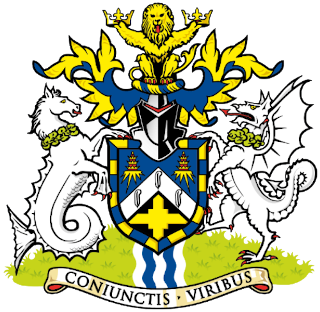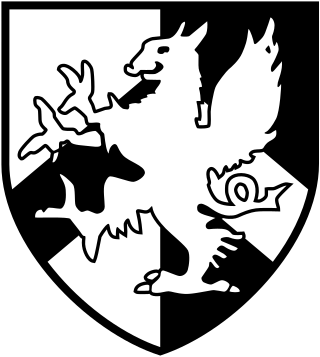
Imperial College London (Imperial) is a public research university in London, England. Its history began with Queen Victoria's husband, Prince Albert, who envisioned a cultural area in South Kensington that included museums, colleges, and the Royal Albert Hall. In 1907, these colleges – the Royal College of Science, the Royal School of Mines, and the City and Guilds of London Institute – merged to form the Imperial College of Science and Technology.

Greenwich is an area in south-east London, England, within the ceremonial county of Greater London. It is situated 5.5 miles (8.9 km) east-south-east of Charing Cross.

Greenwich Hospital was a permanent home for retired sailors of the Royal Navy, which operated from 1692 to 1869. Its buildings, initially Greenwich Palace, in Greenwich, London, were later used by the Royal Naval College, Greenwich and the University of Greenwich, and are now known as the Old Royal Naval College. The word "hospital" was used in its original sense of a place providing hospitality for those in need of it, and did not refer to medical care, although the buildings included an infirmary which, after Greenwich Hospital closed, operated as Dreadnought Seaman's Hospital until 1986.

St Thomas' Hospital is a large NHS teaching hospital in Central London, England. Administratively part of the Guy's and St Thomas' NHS Foundation Trust, together with Guy's Hospital, Evelina London Children's Hospital, Royal Brompton Hospital and other sites. It is also a member of King's Health Partners, an academic health science centre, and is one of three sites used by King's College London GKT School of Medical Education.

Queen Mary University of London is a public research university in Mile End, East London, England. It is a member institution of the federal University of London.

The Queen's Medical Centre is a teaching hospital situated in Nottingham, England. Until February 2012, when it was surpassed by the Royal London Hospital, it was the largest hospital in the United Kingdom, though it remains the largest major trauma centre in England. It is managed by Nottingham University Hospitals NHS Trust.

Barts and The London School of Medicine and Dentistry, commonly known as Barts or BL, is a medical and dental school in London, England. The school is part of Queen Mary University of London, a constituent college of the federal University of London, and the United Hospitals. It was formed in 1995 by the merger of the London Hospital Medical College and the Medical College of St Bartholomew's Hospital.

The Royal London Hospital is a large teaching hospital in Whitechapel in the London Borough of Tower Hamlets. It is part of Barts Health NHS Trust. It provides district general hospital services for the City of London and Tower Hamlets and specialist tertiary care services for patients from across London and elsewhere. The current hospital building has 1248 beds and 34 wards. It opened in February 2012.

Mile End is an area in London, England and is located in the London Borough of Tower Hamlets. It is in East London and part of the East End. It is 4.2 miles (6.8 km) east of Charing Cross. Situated on the part of the London-to-Colchester road called Mile End Road, it was one of the earliest suburbs of London.
Dunkirk is a residential area of Nottingham, England which is located to the south-east of the University of Nottingham and the Queen's Medical Centre. It is in the electoral ward of 'Dunkirk and Lenton', part of the Nottingham South constituency, with a population of 10,920 in the 2011 census.

Westfield College was a small college situated in Hampstead, London, from 1882 to 1989. It was the first college to aim to educate women for University of London degrees from its opening. The college originally admitted only women as students and became coeducational in 1964. In 1989, it merged with Queen Mary College. The merged institution was named Queen Mary and Westfield College until 2000, when the name was publicly changed to Queen Mary University of London.

The Jordan University of Science and Technology, often abbreviated JUST, is a public technological university located on the outskirts of Irbid, at Ar Ramtha in northern Jordan. The university comprises twelve faculties that offer a spectrum of undergraduate and higher study programs, in addition to King Abdullah University Hospital which is a tertiary teaching hospital affiliated with JUST and located within its campus.

Hammersmith Hospital, formerly the Military Orthopaedic Hospital, and later the Special Surgical Hospital, is a major teaching hospital in White City, West London. It is part of Imperial College Healthcare NHS Trust in the London Borough of Hammersmith and Fulham, and is associated with the Imperial College Faculty of Medicine. Confusingly the hospital is not in Hammersmith but is located in White City adjacent to Wormwood Scrubs and East Acton.

The London Hospital Medical College was a medical and later dental school based at the London Hospital in Whitechapel, London. Founded in 1785, it was the first purpose-built medical college in England. It merged with the Medical College of St Bartholomew's Hospital in 1995 to form Barts and The London School of Medicine and Dentistry, which in 2022 became known as the Faculty of Medicine and Dentistry, Queen Mary University of London.

Barts and The London Rugby Football Club, also known as the Royal Hospitals Rugby Football Club, is the rugby club of Barts and The London School of Medicine and Dentistry. They have held the United Hospitals Cup, the oldest rugby cup competition in the world, for 3 years (2022–2024).
St Bartholomew's and The Royal London Hospitals FC ("SBLHFC") are the football club of Barts and The London School of Medicine and Dentistry, having been formed from the merger of two formerly distinct hospital football clubs each with a long history.
Mary Katharine Levinge Collins, Lady Hunt is a British Professor of virology and the director of the Queen Mary University of London Blizard Institute. She served as Provost at the Okinawa Institute of Science and Technology in Japan. Formerly, Collins taught in the Division of Infection and Immunity at University College London, and was the head of the Division of Advanced Therapies at the National Institute for Biological Standards and Control, and the Director of the Medical Research Council Centre for Medical Molecular Virology. Her research group studies the use of viruses as vectors for introducing new genes into cells, which can be useful for experimental cell biology, for clinical applications such as gene therapy, and as cancer vaccines.


















